Serbian cross
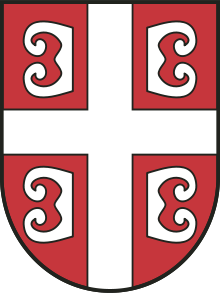
The 'Serbian cross is a national symbol of Serbia, part of the Coat of arms of Serbia, flag of Serbia and the Serbian Orthodox Church. Essentially, it is cross surrounded with a four signs of fire striker (or fire steel) what is a piece of high carbon or alloyed steel from which sparks are struck by the sharp edge of chert or similar rock.[1] [2][3]
For modern fire strikers, also called "artificial flints", see ferrocerium.
Serbian cross although older symbol, have similarity with the tetragrammatic cross emblem of the Byzantine Palaiologos dynasty, with the difference that in Serbian use the cross is usually white on a red background, rather than gold on a red background (though it can be depicted in gold as well).
Popular interpretation about four stylized letters on each of corners of Serbian cross cross symbol state that those letters represent S (С) in Cyrillic alphabet. The Serbian tradition attributes the symbol to St. Sava, 12th century metropolitan of Žiča and Archbishop of Serbs, creation of the popular motto from those four letters, Only Unity Saves the Serbs (Serbian: Само слога Србина спасава/Samo sloga Srbina spasava).[4]
The double-headed eagle and the cross are the main heraldic symbols which represent the national identity of the Serbian people across the centuries.[5]
Origin
Crosses with firesteels have been used since time immemorial, in Proto-Slavic and later in Roman times, in the Middle Ages and the Viking Age.[3][6] as symbols, but not as coats of arms or emblems.[7] Some historians connect it with the labarum, the Imperial flag of Constantine the Great (r. 306–337).[7] In the 6th century the cross with four fields (with either letters or heraldry), tetragramme, appear on Byzantine coins.[8] The symbol was adopted by the First Crusaders since the first event, People's Crusade (1096).[8] Michael VIII Palaiologos (1261–1282) adopted the symbol when he resurrected the Byzantine Empire, with the initials (letters β) of the imperial motto of the Palaiologos dynasty: King of Kings, Ruling Over Kings (βασιλεὺς βασιλέων, βασιλεύων βασιλευόντων Basileus Basileōn, Basileuōn Basileuontōn).[8] It was used in flags and coins.[8]
In early times, percussion firemaking was often used to start fires, from the Iron Age forward, until the invention of the friction match, the use of flint and steel was a common method of firelighting. Before the advent of steel, a variety of iron pyrite or marcasite was used with flint and other stones to produce a high-temperature spark that could be used to create fire.[9] There are indications that the "Iceman" called Ötzi may have used iron pyrite to make fire.[10]
History
Middle Ages
The oldest preserved historical source of the cross is from the Dečani oil-lamp (Dečanski polijelej), which was a gift to King Stefan Milutin (r. 1282–1321), the ktetor (founder) of Visoki Dečani, now preserved at the Monastery of Prohor Pčinjski.[11]
Stojan Novaković argues that the recorded use of the Serbian cross, as a national symbol, began in 1397, during the rule of Stefan Lazarević.[12] It was possibly derived from the Dečani polijelej.[12] Serbian historian Stanoje Stanojević argues that it entered its use in 1345, with Stefan Dušan's elevation to Emperor.[13] In the Middle Ages, both the "Greek style", with closed fire-steels (β - B), and the "Serbian syle", with open fire-steels (C - S), were used in Serbia.[14]
A 1439 map by Gabriel de Vallseca used both the Serbian cross and eagle when depicting Serbia.
South Slavic armorials
_(14th_century).svg.png)
In South Slavic heraldic sources (also known as "Illyrian Armorials"), the Serbian cross is found in the Korenić-Neorić Armorial (1595), which shows the coat of arms of Serbia (Svrbiae) as a white cross over a red background, with four firesteels, also depicting the Mrnjavčević noble house with the same design, with inverted colours and the Serbian eagle in the center of the cross. According to Mavro Orbini (1607), it was used by Vukašin Mrnjavčević (King, 1365–1371) and Lazar Hrebeljanović (Prince, 1371–1389).[13] Next, it is found in the Belgrade Armorial II (ca. 1600–1620), the Fojnica Armorial (between 1675–1688), the Armorial of Stanislaus Rubcich (ca. 1700), and Stemmatographia (1741), while still continuing to be used in foreign heraldic sources.
Official use
The Metropolitanate of Karlovci, established in 1691, adopted it in its seal.
After the Serbian Revolution, the Serbian cross then appeared on all official Serbian coats of arms, except the Serbian coat of arms adopted in 1974, which had the cross removed, leaving four stylized S; this was done symbolically by the Yugoslav government to "socially curtail and politically marginalize religious communities and religion in general".[15] During WWII, The Serbian cross was used in the Nazi backed puppet government, Government of National Salvation Flag (1941–1944). Miloš Obrenović adopted the Serbian cross as the military flag when forming the first units of the regular army in 1825.[16]
Legacy
The Serbian cross symbol has been frequently used in Serb heraldry.[17]
The memorial park in Tekeriš, where the first battle of the Great War was fought, the monument has "18-VIII-1914" and "Samo sloga srbina spasava" inscribed. A monument in Šamac, Republika Srpska, Bosnia-Herzegovina for the Serbs who fought and died in the Bosnian war, has the Serbian eagle in the center, the years which the war occurred (1992-1995) and the Serbian slogan: "Samo Sloga Srbina Spasava" on the left and right sides.[18]
Examples
Flags
-

State flag of Serbia
-

Flag of the Serbian Orthodox Church
Historical coats of arms and flags
-
%2C_prema_portolanu_Gabriel_de_Vallseca.jpg)
Flag and coat of arms of the Serbian Empire, Gabriel de Vallseca (1439).
-

Serbia, Belgrade Armorial II (ca. 1600–1620)
-
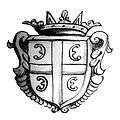
Coat of arms of Serbs (17th century), ed. of Mavro Orbini's Regno degli Slavi (1601)
-

Coat of arms of the Metropolitanate of Karlovci (1713)
-

Flag of the First Serbian Uprising and Topola, 1804
-
Government seal
(First Serbian Uprising, 1805–1813) -

Coat of arms of Prince Miloš I (1819)
-

Principality of Serbia
(1835–1882) -
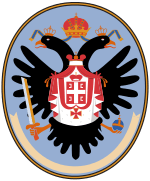
Serbian Vojvodina
(1848–1849) -

Civil flag of Serbia (1869)
-
.png)
Coat of arms of Prince Peter I (1903–1918)
-
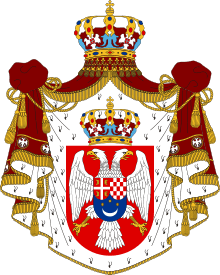
Kingdom of Yugoslavia (1918–1944)
-

Government of National Salvation (1941–1944)
-
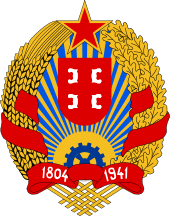
Socialist Republic of Serbia (1947–1992) and Republic of Serbia (1992–2004)
-

Federal Republic of Yugoslavia (1992-2003) Serbia and Montenegro (2003–2006)
-
.svg.png)
Kingdom of Serbia (1882–1918) and Republic of Serbia
(2004–2010)
Cities and municipalities in Serbia
Cities and municipalities in Bosnia and Herzegovina
Cities and municipalities elsewhere
-

Staro Nagoričane, R. Macedonia
Other uses
References
- ↑ Bush, Darren. "Traditional Firestarting Part I: How to Make Fire with Flint and Steel". Manly Skills, Self-Reliance, Survival. Art of Manliness. Retrieved 27 July 2015.
- ↑ "Do you have 5 Ways to Make Fire?". Survival Cache. Retrieved 27 July 2015.
- 1 2 "Fire from Steel - Custom forged fire steels from Roman through Fur Trade time periods". Angelfire.com. Retrieved 2013-07-21.
- ↑ Only the Nails Remain: Scenes from the Balkan Wars
- ↑ Atlagić 2009, p. 180.
- ↑ "Viking Answer Lady Webpage - Viking Age Fire-Steels and Strike-A-Lights". Vikinganswerlady.com. Retrieved 2013-07-21.
- 1 2 Atlagić 1997, p. 1.
- 1 2 3 4 Atlagić 1997, p. 2.
- ↑ http://www.primitiveways.com/marcasite%20and%20flint.html
- ↑ http://www.iceman.it/en/mapleleaves
- ↑ Atlagić 2009, p. 182.
- 1 2 Atlagić 1997, p. 4.
- 1 2 Atlagić 1997, p. 5.
- ↑ Atlagić 1997, p. 3.
- ↑ Mitja Velikonja (2003). Religious Separation and Political Intolerance in Bosnia-Herzegovina. Texas A&M University Press. pp. 187–. ISBN 978-1-60344-724-9.
nations (in a symbolical sense as well, for example, by removing the cross from the Serbian coat of arms but keeping the four stylized esses), and to socially curtail and politically marginalize religious communities and religion in general.
- ↑ Posebna izdanja 295. Srpska Akademija Nauka i Umetnosti. 1957. p. 133.
- ↑ Anarheologija Slika 5: Srpski štit, grb Despotovine od početka XV veka.
- ↑ Jean-Arnault Derens, EU plans trade routes across the continent
Sources
- Atlagić, Marko (1997). "The cross with symbols S as heraldic symbols" (PDF). Baština. 8: 149–158. Archived from the original (PDF) on May 21, 2013.
- Atlagić, Marko (2009). "Određivanje nacionalnih heraldičkih simbola na primjeru Srba i Hrvata" [Étude des symboles nationaux héraldiques à l' exemple des Serbes et des Croates] (PDF). Zbornik radova Filozofskog fakulteta u Prištini. 39: 179–188.
- Atlagić, Marko (2007). "Dečanski polijelej" (PDF). Baština. 22: 245–250.
- Milićević, Milić (1995). Grb Srbije: razvoj kroz istoriju. Službeni glasnik.
- Palavestra, Aleksandar (June 1998). "O ocilima" (PDF). Glasnik SHD (in Serbian). Archived from the original (PDF) on 2013-10-29.
- Solovjev, Aleksandar Vasiljevič (1958). Istorija srpskog grba. Srpska misao.
- Stanojević, Stanoje (1934). "O srpskom grbu". Iz naše prošlosti. Belgrade: Geca Kon A. D. pp. 85–90.
External links
- Борис Субашић (16 March 2014). "Србија сачувала симболе Византије" (in Serbian). Novosti.
See also
| Wikimedia Commons has media related to Serbian cross. |
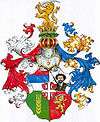




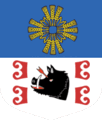



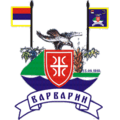
.png)

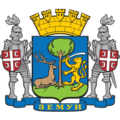
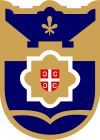
.svg.png)
.svg.png)

.svg.png)
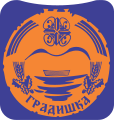
.svg.png)
.svg.png)
.svg.png)
.svg.png)

.jpg)

